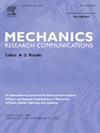Thermomechanical buckling response of precompressed sandwich plate with foam metal core and symmetric FGM face layers subjected to magnetic field and Pasternak foundation
IF 1.9
4区 工程技术
Q3 MECHANICS
引用次数: 0
Abstract
This study uses the new trigonometric higher-order shear deformation theory to describe and investigate the thermomechanical buckling response of sandwich plates with a foam core layer and two symmetric FGM surface layers. The sandwich plate, exposed to the external magnetic field, is supported by the Pasternak foundation, and three types of metal foam (Nickel foam) supported by Graphene are employed in the core layer, while metal (Nickel) and ceramic (Al2O3) are utilized as symmetric FGM in the surface layers. The equations incorporated axial compressive forces, as well as additional forces caused by thermal and magnetic fields, forces from the foundation, and Hamilton's principle was used to obtain the sandwich plate's motion equation. The thermal buckling behavior of the sandwich plate is affected by the properties of the foam structure in the core layer (foam void ratio and foam distribution form), the material mixture ratios of FGM surface plates, the effect of axial loads, the effect of temperature rise, the effect of the external magnetic field, and the effects of spring and shear foundation parameters. It has been observed that especially the applied external magnetic field can be used to improve the thermal buckling behavior of the sandwich plate. Moreover, the specific type of foam core significantly influences the thermal buckling behavior. While one type of foam core has superior performance up to a specific temperature, the other type demonstrates increased susceptibility to thermal buckling.
求助全文
约1分钟内获得全文
求助全文
来源期刊
CiteScore
4.10
自引率
4.20%
发文量
114
审稿时长
9 months
期刊介绍:
Mechanics Research Communications publishes, as rapidly as possible, peer-reviewed manuscripts of high standards but restricted length. It aims to provide:
• a fast means of communication
• an exchange of ideas among workers in mechanics
• an effective method of bringing new results quickly to the public
• an informal vehicle for the discussion
• of ideas that may still be in the formative stages
The field of Mechanics will be understood to encompass the behavior of continua, fluids, solids, particles and their mixtures. Submissions must contain a strong, novel contribution to the field of mechanics, and ideally should be focused on current issues in the field involving theoretical, experimental and/or applied research, preferably within the broad expertise encompassed by the Board of Associate Editors. Deviations from these areas should be discussed in advance with the Editor-in-Chief.

 求助内容:
求助内容: 应助结果提醒方式:
应助结果提醒方式:


